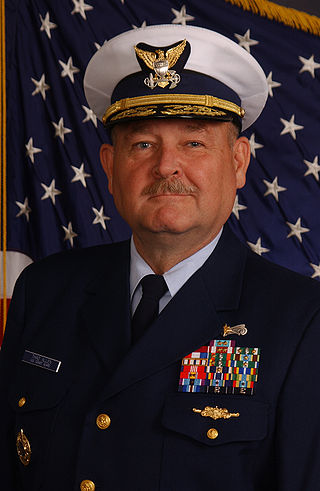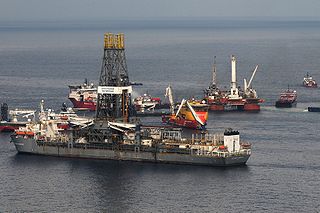
Texas City is a city in Galveston County, Texas, United States. Located on the southwest shoreline of Galveston Bay, Texas City is a busy deepwater port on Texas's Gulf Coast, as well as a petroleum-refining and petrochemical-manufacturing center. The population was 51,898 at the 2020 census, making it the third-largest city in Galveston County, behind League City and Galveston. It is a part of the Houston metropolitan area. It is notable as the site of a major explosion in 1947 that demolished the port and much of the city.

The United States Coast Guard Auxiliary is the uniformed, non-military volunteer component of the United States Coast Guard. Congress established the unit on 23 June 1939, as the United States Coast Guard Reserve. On February 19, 1941, the entity was renamed the United States Coast Guard Auxiliary. The Auxiliary's purpose is to bolster all USCG undertakings both at sea and in the sky, with the exception of tasks necessitating "direct" law enforcement or military actions. As of 2022, the U.S. Coast Guard Auxiliary boasted around 21,000 members.

The Incident Command System (ICS) is a standardized approach to the command, control, and coordination of emergency response providing a common hierarchy within which responders from multiple agencies can be effective.

Thad William Allen is a former admiral of the United States Coast Guard who served as the 23rd commandant from 2006 to 2010. Allen is best known for his performance directing the federal response to hurricanes Katrina and Rita in the Gulf Coast region from September 2005 to January 2006, and for his role as National Incident Commander of the Unified Command for the Deepwater Horizon oil spill in the Gulf of Mexico in 2010. Robert J. Papp Jr. succeeded him as Commandant on 25 May 2010.

Deepwater Horizon was an ultra-deepwater, dynamically positioned, semi-submersible offshore drilling rig owned by Transocean and operated by the BP company. On April 20, 2010, while drilling in the Gulf of Mexico at the Macondo Prospect, a blowout caused an explosion on the rig that killed 11 crewmen and ignited a fireball visible from 40 miles (64 km) away. The fire was inextinguishable and, two days later, on April 22, the Horizon collapsed, leaving the well gushing at the seabed and becoming the largest marine oil spill in history.

Hurricane Ike was a powerful tropical cyclone that swept through portions of the Greater Antilles and Northern America in September 2008, wreaking havoc on infrastructure and agriculture, particularly in Cuba and Texas. Ike took a similar track to the 1900 Galveston hurricane. The ninth tropical storm, fifth hurricane, and third major hurricane of the 2008 Atlantic hurricane season, Ike developed from a tropical wave west of Cape Verde on September 1 and strengthened to a peak intensity as a Category 4 hurricane over the open waters of the central Atlantic on September 4 as it tracked westward. Several fluctuations in strength occurred before Ike made landfall on eastern Cuba on September 8. The hurricane weakened prior to continuing into the Gulf of Mexico, but increased its intensity by the time of its final landfall in Galveston, Texas, on September 13 before becoming an extratropical storm on September 14. The remnants of Ike continued to track across the United States and into Canada, causing considerable damage inland, before dissipating on the next day.

USNS American Explorer (T-AOT-165) was a tanker built for the United States Military Sea Transport Service. The tanker was built by Ingalls SB of Mississippi in 1958, and at the time her keel was laid, the vessel was intended to be the world's first nuclear-powered tanker, but was completed with a conventional steam power plant. The ship was transferred to the US Maritime Administration in 1984 and was part of the US Reserve Fleet, Beaumont Reserve Fleet, Texas. American Explorer was sold for scrap on 8 July 2008 to the Southern Scrap Metal Corporation in New Orleans, Louisiana. On 13 August, two weeks before Hurricane Gustav struck the Southeastern Louisiana coastline, the tanker was moved to New Orleans' Industrial Canal.

USNS Courier was a cargo ship of the National Defense Reserve Fleet. The cargo ship was built by Sun Shipbuilding and Drydock Company, Chester, Pennsylvania, at the request of the US Maritime Administration in 1962. The ship was 470 ft in length and has a breath of 73 and weighs 11420 tons, empty. The ship was originally administered by American Export Lines under the civilian name SS Export Courier and eventually became part of the James River Reserve Fleet. The company ran into financial trouble in 1977. Before 1981, Farrell Lines, which took over parts of the dissolved American Export Lines, transferred administration of the Courier to the Military Sealift Command, which renamed the ship USNS Courier. The ship was officially accepted as part of the Maritime Administration in February 1983. From 1981 it was stationed with the Beaumont Reserve Fleet or docked at Port Neches, Beaumont Texas. Service records indicate repairs after Operation Desert Storm. In 2001 the ship was transferred to the National Defense Reserve Fleet and remained in this status until July 2008 when it was sold to Southern Scrap Metal Corporation of New Orleans, Louisiana and subsequently transferred to New Orleans' Industrial Canal on 13 August, a little more than two weeks before Hurricane Gustav reached Louisiana's southeastern coast.

Hurricane Ike caused major destruction in Texas with crippling and long-lasting effects, including death, widespread damage, and impacts to the price and availability of oil and gas. Hurricane Ike also had a long-term impact on the U.S. economy. Making landfall over Galveston as a Category 2 hurricane, at 2:10 a.m. CDT on September 13, 2008, Hurricane Ike caused extensive damage in Texas, with sustained winds of 110 mph (180 km/h), a 22 ft (6.7 m) storm surge, and widespread coastal flooding.
The name California Fire Safe Council (CFSC) has been used for two very different organizations. The original use of the name, from 1993 through mid-2002, referred to a loose consortium of local community-based fire safe councils and other organizations that shared the mission of making California's communities less vulnerable to catastrophic wildfire. It was funded by the state of California Resources Agency, Department of Conservation, Division of Forestry, also called CDF or CAL FIRE. It was led by staff from the CDF Prevention Bureau.

The Cosco Busan oil spill occurred at 08:30 UTC-8 on 7 November 2007 between San Francisco and Oakland, California, in which 53,569 US gal (202,780 L) of IFO-380 heavy fuel oil, sometimes referred to as "bunker fuel", spilled into San Francisco Bay after the container ship Cosco Busan, operated by Fleet Management Limited struck Delta Tower of the San Francisco–Oakland Bay Bridge in thick fog.

On April 20, 2010, an explosion and fire occurred on the Deepwater Horizon semi-submersible mobile offshore drilling unit, which was owned and operated by Transocean and drilling for BP in the Macondo Prospect oil field about 40 miles (64 km) southeast off the Louisiana coast. The explosion and subsequent fire resulted in the sinking of the Deepwater Horizon and the deaths of 11 workers; 17 others were injured. The same blowout that caused the explosion also caused an oil well fire and a massive offshore oil spill in the Gulf of Mexico, considered the largest accidental marine oil spill in the world, and the largest environmental disaster in United States history.

The following is a timeline of the Deepwater Horizon oil spill. It was a massive oil spill in the Gulf of Mexico, the largest offshore spill in U.S. history. It was a result of the well blowout that began with the Deepwater Horizon drilling rig explosion on April 20, 2010.

The Unified Command provides Incident Command System/Unified Command (ICS) for coordinating response to the Deepwater Horizon oil spill.

The EADS HC-144 Ocean Sentry is a medium-range, twin-engined turboprop aircraft used by the United States Coast Guard in the search-and-rescue and maritime patrol missions. Based on the Airbus Military CN-235, it was procured as a "Medium Range Surveillance Aircraft." The HC-144 is supplied by Airbus Group, Inc, formerly EADS North America, and is built in Spain by Airbus Defence and Space.
Following is a Timeline of the Deepwater Horizon oil spill for May 2010.

USCGC Cypress (WLB-210) is a United States Coast Guard cutter and the tenth Juniper-class seagoing buoy tender. She is outfitted with advanced technological and navigational capabilities that allow her to be positioned correctly for exact placement of buoys through the use of controllable-pitch propellers and stern and bow thrusters.

The Deepwater Horizon investigation included several investigations and commissions, among others reports by National Incident Commander Thad Allen, United States Coast Guard, National Commission on the BP Deepwater Horizon Oil Spill and Offshore Drilling, Bureau of Ocean Energy Management, Regulation and Enforcement, National Academy of Engineering, National Research Council, Government Accountability Office, National Oil Spill Commission, and Chemical Safety and Hazard Investigation Board.
The 2004 Taylor Energy oil spill is an ongoing spill located in the Gulf of Mexico, around 11 miles (18 km) off the coast of the U.S. state of Louisiana. It is the result of the destruction of a Taylor Energy oil platform during Hurricane Ivan in 2004. It is the longest-running oil spill in U.S. history. It was first brought to public attention when contamination at the site was noticed in 2010 by those monitoring the nearby Deepwater Horizon oil spill. A report by the Associated Press in 2015 challenged the estimates of the extent of the leak originally given by the company and the U.S. Coast Guard (USCG), which were then revised to be around 1,000 times greater than initially reported.















